This week’s Monday Roundup is sponsored by Hassalo on Eighth, now leasing in the Lloyd District.
Here are the bike-related links from around the world that caught our eyes this week:
Adhesive cars: Google has patented a “sticky layer” to hold people on the hood of self-driving cars after a collision.
Car ethics: Should a robot car choose to kill its driver or a child in front of it? There’s a more fundamental ethical question, says N+1. “Why was the car going so damn fast in the first place?”
Vancouver BC bike sharing: It’s finally launching June 30.
“Crash” vs “accident”: The NYT science section covers the language debate.
Train-track priority: Amtrak usually gets it, due to an ambiguous federal mandate, but the freight train industry wants it back.
Barcelona superblocks: The Spanish city is considering restricting through motor traffic to one street every three blocks, creating “superblocks” that you can bike or walk through but not drive through.
Uber apartments: A huge new real estate development in San Francisco is finding it cheaper to pay residents a $100 transportation stipend, plus capping their Uber Pool fees to the nearest transit station, rather than construct more parking.
Advertisement
Transit parking: Greater Los Angeles is debating whether its new rail line should have ringed its stations with free park-and-rides.
Self-driving trucks: A startup founded by former Google, Apple and Tesla workers is betting that retrofitted freight rigs will go autonomous first.
Self-driving cars: Autonomous cars will increase driving, a new report predicts, because “the biggest cost of car travel is drivers’ time.”
Cycling city: The Dutch Cyclists’ Union has named Nijmegen its cycling city of 2016.
Future city: The United States can’t afford to become anything but Boulder, Colorado, argues a Guardian columnist.
Austin target: Texas’s capital is aiming for less than half its trips to happen in cars by 2040.
Why bike: Streetfilms asked some New Yorkers. “It is safer, it is healthy, and MTA is falling apart.”
Decongesting NYC: A decongestion charge on Manhattan traffic would raise $1.35 billion a year to upgrade the city’s packed subways, said the NYT in a glowing editorial about the MoveNY proposal.
Gridlock Sam: The former NYC transportation commissioner (who helped coin the word) has led creation of MoveNY and gets a nice profile in NextCity.
Sadiq Khan: London’s new mayor made a campaign promise to double the cycling budget to $237 million a year.
If you come across a noteworthy bicycle story, send it in via email, Tweet @bikeportland, or whatever else and we’ll consider adding it to next Monday’s roundup.
— Michael Andersen, (503) 333-7824 – michael@bikeportland.org
Our work is supported by subscribers. Please become one today.


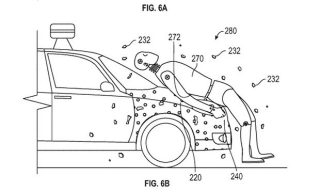
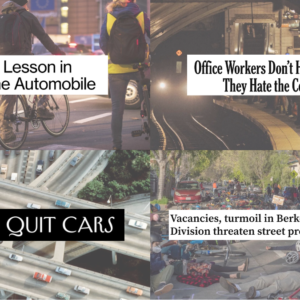
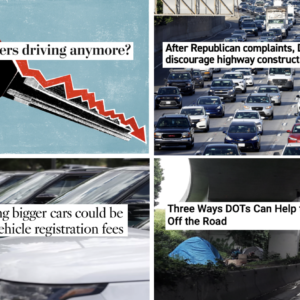
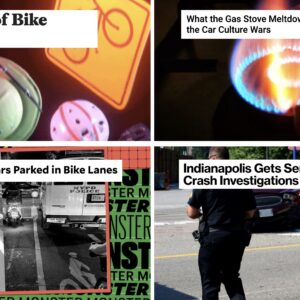
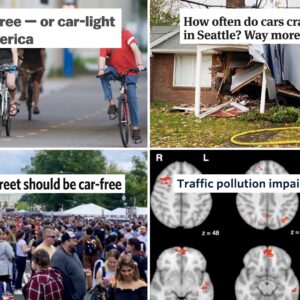
Thanks for reading.
BikePortland has served this community with independent community journalism since 2005. We rely on subscriptions from readers like you to survive. Your financial support is vital in keeping this valuable resource alive and well.
Please subscribe today to strengthen and expand our work.
The stoned driving article puts a caption about marijuana being a dangerous substance, unlike alcohol, next to a photo of a car crash?
If legal weed is really causing more traffic fatalities maybe statistics will show it. None of the statistics quoted in the article do!
Fatal crashes actually increased 1.7%, which is less than the increase in the population.
http://reason.com/blog/2016/05/16/anti-pot-analyst-claims-fatal-crashes-in
I’d be glad if you’d explain what your concern is, about claims made, suggesting marijuana may be a more dangerous substance than alcohol, in using the road by whatever mode of travel.
Used excessively by people driving, biking, walking on the road, etc,, both alcohol and pot are dangerous substances, and it would seem the intoxication of people by either substance, due to increased moves toward legalization, definitely may be increasing frequency of collisions.
In the fairly recent past, by a guy smashed on pot, Portland was provided its very own example of pot likely contributing significantly to a collision that occurred out in East Portland, and in which the pot intoxicated operator of a motor vehicle crashed into a guy on a bike trying to make his way home from work, killing the person.
You are assuming that the people using pot would not be using some other substance (alcohol or worse) if pot were not available. Furthermore, driving fatalities are up majorly all over the country. Opponents in Oregon/Washington/Colorado or going to need to show that the fatality rates have been increasing more in states that have legalized pot. A simple increase is not sufficient on its own.
Wow. I should have checked the source material. Thank you all for catching this. I’m going to remove this junk from the Roundup.
Sorry I didn’t do this yesterday — was out of town.
Sadiq Khan, not to be confused with Sadik-Khan. Okay, I’ll admit it — I was confused.
Self-piloting cars may be okay. The Feds should step up right now, though, and rule that every vehicle must have a licensed human operator inside. No cars whizzing about by themselves!!!!
We don’t require that currently.
Allowing a car to drop off the occupants and then valet itself would be an excellent way to help reduce congestion. And if it were a car-share, would help reduce the overall number of vehicles.
It’s difficult to make commandments about a technology we really don’t yet understand the impacts of.
Or, the single occupant (no one wants to carpool) has the car drop them off, then instructs it to circle the neighborhood, parking periodically when spots are available, and of course, staying just long enough to avoid parking tickets. This is going to be great…
I think cars whizzing around by themselves is precisely what a lot of people envision. This is the next Uber, in their view: you summon an autonomous vehicle to your trip origin, then free it up at your destination (at which point it will again drive with no one in it to the origin of its next taxi-trip). Right now I don’t see any reason to believe this won’t be the reality.
Honestly, I many really don’t understand the implications of driverless tech, it’s so much more than just commuting home. I suspect the demand for individual cars will be almost nonexistent and even if there is demand for individual vehicles they’ll be the lowest profit margin of all the other potential uses and customers.
Obviously for transportation Without the driver and lowered maintenance costs of EV’s coupled with big tech, they’ll be able to offer you faster more reliable, door-to-door shuttle service than Trimet provides. And it will cost them less than public bus service too (though they’ll charge you more – because they can and it will still make economic sense for you to ditch the car). Everyone in your carpool is from your neighborhood and works near where you work. If there are enough people using the services in your areas they could even compose your car pool by personal tastes like all female riders, favorite music, sports teams or any myriad of personal interests all of which Google and Apple already know from your cell phone use.
But even above and beyond personal transportation the implications to freight, grocery, some food service, and delivery services are phenomenal. Why go to the grocery store when you can order a few days worth at a time and have it delivered at no charge to your front door (with driverless tech grocery delivery will be cheaper for the store than for you to go there – given enough time grocery stores might be a thing of past)?
Big box stores, grocery and convenience stores might actually start to fade away in favor of home delivery serviced through big warehouses outside of town. It is already advantageous for large online retailers, driverless tech just makes it more so.
How about Pizza trucks that cooks your pizza to perfection and finishes just as it pulls up to your house? Taco bell? really most fast food places could be easily replaced with a small fleet of mobile restaurant trucks.
In freight, the number of trucks could be dramatically reduced by a fleet that runs nearly 24/7/365, no resting needed. Amazon and some of the bigger retailers will likely turn to driverless fleets cutting out UPS and Fed Express.
And these are just the musings of some guy in SE. But really I don’t see where any company would bother selling these vehicles to individuals without securing their spot in other industries first.
No one is talking about what fuel these vehicles are going to run on. And before you say electricity, you need to think about what will be burned or harnessed to make that electricity, and whether we’re capable of generating and transmitting (and perhaps storing) this additional electricity, above and beyond the level of demand for electricity we currently have.
I agree with a lot of those points, but driverless pizza delivery vehicles, that’s taking things too far! Who’s going to put the pizzas in the oven, take them out, and box them? How do you keep the driverless pizza vehicle from getting mugged for product? If this model is viable, why aren’t pizza restaurants already doing it, just with a driver?
You’ve seen this, yes? You can bet that if they can save money by eliminating the driver they’re already looking into doing just that.
http://www.dominosdxp.com
Or alternatively, the licensed driver could choose to be stuck on the hood!
(I will admit that the G***** patent is an interesting idea)
my guess it that many of these trips will be shared so the proper analogy would be with mass transit, not single occupancy car driving.
Why would autonomous cars’ trips primarily be shared? Some of the vehicles may be serially shared, Uber-style, but the trips will be mostly individual. I think the more accurate current model is taxicabs, not mass transit.
The other way in which autonomous cars may radically increase driving is by putting a lot more people in cars who don’t have them today. Many elderly and disabled people who don’t currently have cars, because they can’t drive, may acquire them. So there are implications not only for the number of miles that will be driven, but the number of vehicles which will require parking.
And I’m still not convinced auto-automobiles will (by themselves) drastically reduce car ownership. I’m hearing talk of a future in which few people own cars, and they just summon the nearest autonomous vehicle when they need to go somewhere. This assumes all cars will be viewed as equal. But the reality is most people view cars as clothing, the way they present themselves to the world, and they want their own pod personalized inside and out. I suspect that when they aren’t driving and use their time in the vehicle in other ways – more of a mobile office – many will want this even more than they do today.
We can avoid this dystopian future by drastically disincentivizing driving and car ownership compared to how we do today, but there’s no guarantee that will happen. Autonomous cars are just another looming reason we need to get serious about cutting back on the dominance of the automobile – and another reason we will encounter resistance.
anyone who has traveled in the 3rd world and used a combi would understand where i am coming from. the use of integrated traffic management systems will make shared vehicle use a no-brainer except for the uber-rich limo crowd, imo.
Boulder is great. Many college towns, especially those with large, flagship universities, are also great. They are also far from typical.
Boulder is 88% white, 9% Hispanic/Latino (the US as a whole is 72% white, 17% Hispanic/Latino), and is much wealthier than a typical American citizen. Wikipedia says, “In 2011 the estimated median household income in Boulder was $57,112, and the median family income was $113,681.”
The median home price in Boulder County is around $470,000 and, in the city of Boulder, the median house price was just shy of $800,000. 63% of county residents can’t afford to buy a house in the county.
(Housing price stats from here: http://www.dailycamera.com/boulder-business/ci_28636516/analysis-63-percent-boulder-county-residents-priced-out)
So, yeah, Boulder is great. Many (most?) rich communities are nice places, too. But how it’s at all typical and suggests anything about the upcoming election is completely baffling.
The Amorality of Self-Driving Cars was well worth a couple of read-throughs. It points out a fundamental flaw in the autonomous-ethics debate:
In the “The Tunnel Problem,” Millar’s driverless car is fast approaching a narrow tunnel, the entrance of which is blocked by a child who has fallen in the roadway. The car can either kill the kid or hit the wall of the tunnel, killing the driver…Millar wants programmers to ask, “How should the car react?” But again, there’s a better question: “Why was the car going so damn fast in the first place?”
The author says that we could solve the speed-kills problem without new technology by simply slowing down. He then pinpoints the barrier to that obvious solution:
Unfortunately, Vision Zero lacks the gee-whiz appeal of the driverless car. Instead of a photogenic Porsche speeding toward a tunnel, the poster child of Vision Zero is heavy traffic moving at 20 miles per hour.
His conclusion, though not very rosy, is extremely thought provoking: that robot cars will not exist outside the current automotive ecosystem, a system that has speed, “personal freedom”, consumerism, and environmental destruction embedded in its DNA.
we’re taking transportation back away from corporations… the people will readjust back to normality…
Wait, what? How does autonomous driving take driving away from corporations? With companies like Google, Apple, and VW/Audi pumping billions into the technologies, as well as companies like Cisco and Intel into the V2V and V2I movement, I think it’s more a shift than removal.
First thought occurring to me when I read the article summary in today’s Roundup: What if the autonomous car, faced with the described ethical dilemma…wasn’t going fast at all?
The answer I believe, whether such vehicles are going fast or slow, is that the safety of the vehicle occupant(s), protected by the enclosure of the motor vehicle, would be subordinate to the safety of the unprotected child.
“…the current automotive ecosystem, a system that has speed, “personal freedom”, consumerism, and environmental destruction embedded in its DNA.”
Speed and personal freedom is less and less the strong attribute of the automotive ecosystem it once was. People today, particularly in and around cities during daytime hours, are locked into a grid of congested streets and highways that essentially limits vehicle speed, whether the vehicle is a Porsche coupe or a Smart Car.
In future, within city limits, vehicle operation largely managed by vehcles’ on board systems and road infrastructure autonomous grid support systems, could become the greatest boon to road user safety since traffic signal lights and seat belts.
Because of autonomous cars, human-driven miles may go down in the future but there will be far more cars on the roads and the impact on the infrastructure could be crippling. I could easily envision a future where the top earners will have several cars out on the road at the same time, driving their family around, getting the dog from doggy daycare, getting take out, etc, especially during peak times. People would even avoid parking costs by having their vehicle drop them off, drive home for the day, then return at the end of the work day.
imo, few people will own an autonomous car/van when they become more mainstream 20+ years from now. why own an expensive and depreciating asset when one can be hailed in a minute or two? moreover, most of these vehicle trips will be shared because doing so will lower costs without affecting convenience.
Um… America wastes vast sums of money on the existing auto culture. And most have no idea how much they actually spend in a given year. People will do whatever is easiest/most convenient, and they will go in to massive debt to make it happen.
existential threat tends to focus the mind:
http://daraint.org/wp-content/uploads/2012/09/CVM2ndEd-FrontMatter.pdf
I think you underestimate the lengths to which the average American will go to have their own personal transportation pod, in which they can listen to entertainment of their choice at their desired volume without having to wear headphones, and in which they don’t have to sit next to strangers. There are huge numbers of people who would objectively be better off without a car, given the costs, maintenance hassles, etc. as you cite, but they still drive.
Although public transport is somewhere between awful and nonexistent in most of America, there are still a lot of places (including much of Portland, and here in Minneapolis too) where a very large number of people who could be taking public transport – saving gobs of money and in many cases time too, are not doing so.
And not just people of means: in poorer communities there is often more resistance to getting out of cars than in communities with lots of professional-class workers, because cars are more strongly seen as status symbols, and as aspirational objects by those who don’t have them.
On another note, taxicabs and Uber exist today. Even if you assume that most Americans are perfectly willing to ride with a stranger if the cost and trip time are the same – a highly dubious assumption – this mode becomes prohibitively expensive if you use it every day, especially for non-short trips.
So … how on earth would autonomous vehicles change all this? Not at all, if we remain on the current trajectory in which cars remain all-dominant and the auto industry (whose business model still depends on millions of us buying cars individually) runs the show.
uber and lyft are expensive because a significant part of the fee pays for the driver’s service. i suspect that autonomous vans/cars will make shared trips (serially or otherwise) cost-competitive with public transit. i also think you dramatically underestimate future congestion pricing, future carbon taxes, and efficiency improvements that will come from integrated traffic management. as for motivation to move away from cars — i think that is inevitable in coming decades. when parents start worrying about their children’s future the kind of change you believe is impossible will become very possible. (possibly too late.)
It’s possible we will see the congestion pricing, high parking fees, fuel taxes, and other disincentives towards personal vehicles that you propose. But I don’t assume these are a given, and we’re certainly not headed that direction at the moment.
If the disincentives rise sharply in tandem with the adoption of autonomous vehicles, then we might see the future you envision. If not, we may have a world where people go somewhere in their personal autonomous car, send it back home because parking costs are high where they are shopping, working, etc., and then summon it again from to come get them when they’re done. Don’t think that people won’t do this.
The title that says that “Fatal driving collisions in Washington State rose 122 percent from 2010 to 2014” is highly inaccurate. According to the Insurance Institute for Highway Safety website, there were 420 highway fatalities in Washington in 2010, and 429 in 2014. A 122% increase would imply that falalities more than doubled in five years. I am not exactly sure if the title is meant to say that fatalities due to marijuana rose 122%, but fortunately the situation is nowhere near as dire as a literal reading of the title implies. While the legalization of marijuana could lead to more highway deaths due to persons driving under the influence, the vast majority of traffic deaths is due to undisciplined drivers and a lack of enforcement of traffic laws.
From the article on marijuana: “According to the Washington State Marijuana Impact Report, the incidents of marijuana-impaired driving are increasing dramatically. Fatal driving accidents have risen 122 percent between 2010 and 2014, according to the Washington State Traffic Safety Commission.”
So the 122 percent is specifically related to “marijuana-impaired driving”? Not overall fatal driving “crashes” in Washington state?
Assuming all 9 wrecks were caused by 4/20 impaired drivers, that would mean there were an average of 7.3 fatal wrecks caused by 4/20 impaired drivers a year. If WA followed the national average that would compare to 126 fatalities blamed on ethanol consumption in 2011. That would mean in 2011 there were 1726% more drunk driver wrecks than stoned driver wrecks.
Also 9 wrecks difference is statistical noise out of 429 total. We get a greater fluctuation than that year to year in bicycle fatalities nationwide and everybody says it is just the noise of having large relative changes in small populations. Or to use another bicycle-specific statistic, in records going all the way back to The Quake in SF history there were only 2 people killed from getting hit by a bicycle, but they were within 4 years of each other. Does this mean cycling is getting deadly for SF pedestrians? Or does it mean that 2 extremely unlikely events happened close together in time?
Yes, this was a dishonest report. I’ve removed it from the Roundup. Thanks and my apologies for not checking the source material better.
Checkmate.
Sounds high.
The 1-in-a-million kill the child or kill the driver automated-car questions are really a straw man, and a distraction from the fact that most crashes are caused by a variety of human error that a machine would not be susceptible to distraction, fatigue, alcohol, or legal weed. I’d gladly accept some unavoidable 1-in-a-million crashes in exchange for the dime-a-dozen crashes we currently experience.
LikeBike June 3-5 Monte-Carlo Grimaldi Forum next month to see what’s happening with the 1% bike and accessory club:
http://likebikemc.com/
Nextportland article highlighting the 40 buildings taller than 100 feet that either under construction, or in the planning stages. This list was just 25 this time last year.
http://www.nextportland.com/2016/05/20/tallest-buildings-2016/
The Amtrak thing is interesting. I recently took the train from Portland to Seattle, and we had to pull into a siding to let a freight train go because, as the conductor said, “Freight has priority on this line”. Maybe it was only a local mandate.
That was always my understanding. Back when I lived in Corvallis and took it from Albany to Seattle, a coworker dating a woman there recommended that I take a later train because it often gets there before the earlier one (due to the freight priority situation). I did, and he was right – we apparently followed a freight train past the sidetracked earlier one.
The Amtrak story surprises me. The Empire Builder, which uses shared BNSF tracks on most of its route from Seattle and Portland to Chicago, is very frequently 5-8 hours late due to conflicts with freight trains.
My understanding is that it is actually pretty unusual for the EB to get to the end of its route on time. This has gotten worse in recent years due to the volume of oil trains serving the Bakken oilfield in North Dakota, through which the EB passes. Good news is Bakken production is finally dropping due to the collapse of oil prices, so hopefully that will help a bit.
But my understanding is our rail system is near capacity pretty much everywhere, and that Amtrak sees frequent delays across its system as a result.
In the “kill the driver or kill the pedestrian” question, unless the speed is very high or passenger protection inside self-driving cars is drastically reduced to the point that hitting something is as deadly to a passenger as hitting someone outside the car, the choice is always “crash the car”. Assuming crash standards remain the same, hitting a concrete wall at 35 MPH is a bandaid or ice pack for anyone inside the car, hitting someone outside a car at the same speed is roughly 70% fatal for that person outside a car.